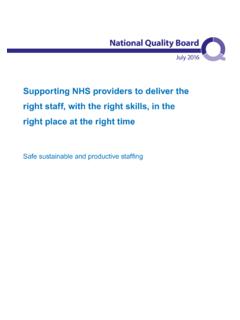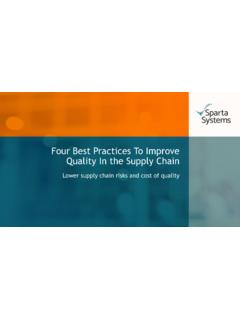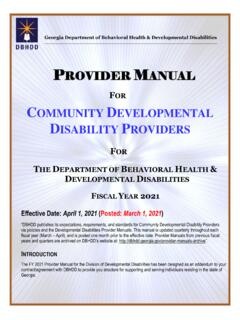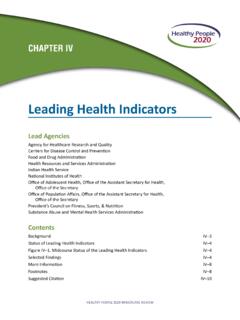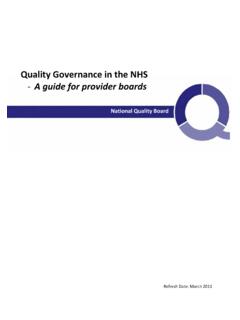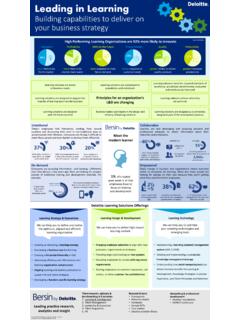Transcription of Reimagining WASH WATER SECURITY FOR ALL - UNICEF
1 WAT E R SECURITYFOR ALLR eimagining WASHThe world is in a WATER crisis, and children s lives and futures are at WASH WATER SECURITY for allWAT E R SECURITYFOR ALLR eimagining WASHThe world is in a WATER crisis, and children s lives and futures are at WASH WATER SECURITY for all3 Reimagining WASH WATER SECURITY for allFor children, WATER is life: without it they cannot survive. Safe drinking WATER is essential for their health and survival, and unsafe WATER can make them sick or even kill them. But a lack of safe WATER , sanitation and hygiene (WASH) affects more than just children s health. It affects their physical development, exacerbating malnutrition and stunting. It affects their education, disrupting learning and sometimes forcing them to skip school to walk long distances to collect WATER .
2 WATER scarcity reduces livelihood opportunities for their families and communities, leading to migration, conflict and even child labour. UNICEF /UN055941/Gilbertson VII Photo4 Reimagining WASH WATER SECURITY for allToday, billion people including 450 million children live in areas of high or extremely high WATER than 3 per cent of the world s WATER resources is freshwater, and it is growing increasingly Decades of misuse, poor management, over-extraction of groundwater and contamination of freshwater supplies have exacerbated WATER stress. At the same time, demand for WATER is rising due to rapid population growth, urbanization and increasing WATER needs from a range of sectors, notably agriculture, industry and change is also compounding WATER scarcity through changing precipitation patterns and increased WATER demand.
3 Many changes in climate are felt through WATER droughts, floods and rising sea levels and extreme weather events can damage vital WATER and sanitation infrastructure and services in homes, communities, schools, health-care facilities and food supplies. Rising sea levels can lead to saltwater intrusion, contaminating drinking WATER supplies. Rapid melting of glaciers changes the river flow patterns in the downstream areas, contributing to risks of flooding, damage to infrastructure (including dam bursts), as well as low flows in rivers, reducing the amount of WATER available. WATER scarcity and climate change are also drivers of conflict and migration, as communities and entire populations compete for shrinking WATER resources. Families may be forced to leave their homes in search of reliable WATER supplies and livelihood opportunities, often moving to urban areas and towns, putting even more pressure on already strained resulting impact on children s health, development, and safety threatens the significant progress made in child survival and sustainable development over the past several decades.
4 It is putting children s lives at risk today and threatens future generations. 1 WATER vulnerability for this analysis relates to physical WATER scarcity risks (Baseline WATER stress; inter and seasonal variability; groundwater decline and droughts) and the WATER service billion people450childrenmillionlive in areas of high or extremely high WATER WASH WATER SECURITY for allWater scarcity2 WATER scarcity exists where the demand for WATER exceeds supply and where available WATER resources are approaching or have exceeded sustainable limits. WATER scarcity can either be physical or WATER scarcityOccurs where WATER resources are over-exploited for different uses and no longer meet the needs of the population. Economic WATER scarcityWhere poor governance, limited capacity, infrastructure and limited investments are among the drivers of economic WATER scarcity.
5 This type of WATER scarcity may occur in countries with adequate WATER stressiiWater stress is an outcome of WATER scarcity and refers to scarcity in terms of quality and accessibility. WATER stress may manifest in conflict over WATER resources, over-extraction, or poor health and WATER scarcityiiiOccurs where annual WATER supply availability is less than 500 cubic metres per person per year. However, this metric has been developed as a global average, applied in varying contexts and includes different uses of WATER , not only securityThe capacity of a population to safeguard sustainable access to adequate quantities of and acceptable quality WATER for sustaining livelihoods, human well-being, and socio-economic development, for ensuring protection against waterborne pollution and WATER -related disasters, and for preserving ecosystems in a climate of peace and political ,3 WATER insecurity occurs when any or all of these needs cannot be WATER vulnerabilityExtreme WATER Vulnerability is the combination of the highest levels of physical WATER scarcity risks and lowest levels of drinking WATER service that affects a given population (surface WATER .)
6 Unimproved or limited WATER service).4,52 WATER scarcity is a relative, dynamic concept, and the local context will determine how and why supply is not meeting demand. Several different definitions for WATER scarcity exist, which include different methods of measuring levels of WATER scarcity. More recent methods are focused on determining levels of WATER stress based on temporal (spatial or geographic determinations of WATER availability within a country or region) and seasonal fluctuations in WATER resources at different times of the year. Primary indicators of WATER scarcity have typically focused on average exposure of WATER users in each country to baseline WATER stress, defined as the ratio of total withdrawals to total available This is a working definition based on UN- WATER s WATER SECURITY and the Global WATER Agenda report.
7 UNICEF will contribute to four dimensions of WATER SECURITY solutions as outlined at the end of this A limited WATER service is an improved source for which collection time exceeds 30 minutes for a roundtrip including queuing (JMP, Progress on drinking WATER , sanitation and hygiene 2000 2017)5 UNICEF s conceptualization based on analysis of the interplay between access and physical WATER CONCEPTS6In 2014, Tripoli s WASH infrastructure and services were essentially destroyed as a result of conflict and prolonged neglect. The government WATER service provider tried to connect the WATER supply from the newly rehabilitated WATER networks in the predominantly Sunni neighbourhood of Quobbe to deliver WATER to Jabal Mohsen, predominantly Alawite. But Quobbe residents motivated by simmering tensions and conflict filled in the trenches dug by the contractor and pushed out the government WATER service groups, including the NGO Lebanese Relief Council (LebRelief), intervened by bringing Tripoli communities together to address gaps in WATER service, behaviour change, and building social cohesion.
8 This included a WASH fair to raise awareness of the poor WASH conditions and their impact on community health and well-being. Young people played a central role in organizing the fair and promoting participation by both the Alawite and Sunni Muslim communities. They also organized a large community theatrical performance to communicate key WASH messages and address everyday experiences of Tripoli brought together community leaders and government service providers to discuss WATER and sanitation infrastructure and improving services for all. Tripoli youth from the Alawite and Sunni Muslim communities were given skills training and employment opportunities, and many helped implement the WASH infrastructure improvements. Marginalized youth were also trained to rehabilitate spaces used as impromptu dumps and turn them into child-friendly green spaces, learning skills for future changes not only brought social cohesion and trust, but also made the WATER services more sustainable.
9 Residents of these communities started to pay affordable fees for their safe WATER supply for the first time in peacebuilding through WASH interventions in Tripoli, Lebanon UNICEF /UN076933/Ibarra S nchez / MeMo7 Reimagining WASH WATER SECURITY for allAccess to safe WATER is not only paramount to children s survival, it is also an essential component for other areas of their development including health, nutrition, education, safety and eventually, and nutritionIncreasing WATER scarcity affects children s health. Every day, over 700 children under age 5 die from diarrhoea linked to unsafe WATER , sanitation and poor When children get sick with diarrhoea, they are unable to absorb the nutrients they need to grow. Over time this can lead to stunting and may irreversibly impact children's physical and mental development.
10 About 144 million children under 5 worldwide are , development and safetyWhen WATER sources dry up, children may be forced to drop out of school to be able to spend more time collecting WATER from sources that are farther away. Not only does this disrupt their schooling, it also places a great physical burden on children as they carry heavy loads of WATER . When schools do not have adequate WATER , children are ill equipped for learning, studying and practicing safe hygiene like scarcity can have an especially adverse effect on girls, as the task of collecting WATER most often falls on them. Not only does this cause them to miss school, or to drop out, but also potentially places them in harm s way when they are forced to walk long distances to WATER sources. During menstruation, girls may be less likely to attend school if it does not have adequate WATER and sanitation facilities to help them manage their periods.










